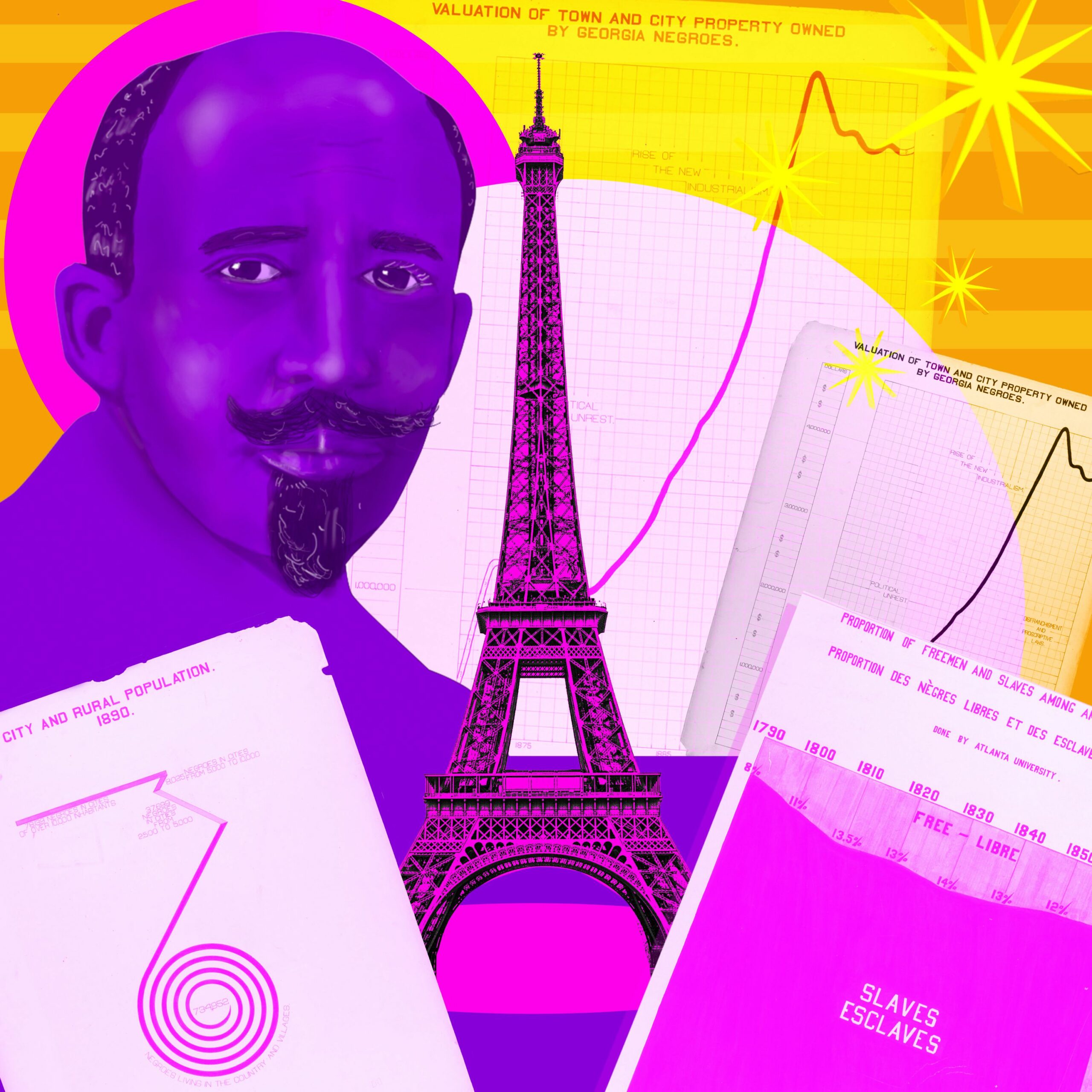
The 1893 World’s Fair in Chicago was an opportunity for the United States to showcase its spectacular growth and signal its arrival as a world power, but it failed to highlight Black Americans’ role in its development, and they took notice.
So when Paris hosted the Exposition Universelle in 1900, African Americans knew creating space to showcase their progress to the world was of major importance.
Among the exhibition’s attendees was W.E.B. Du Bois. He seized the opportunity to present factual evidence of Black achievement to dispel international stereotypes and convince world powers to apply pressure to the United States to dispel white supremacy and live up to its founding principles.
View Transcript
Over 6 months, 48 million attendees poured in from around the globe to view showcases of countries’ intellectual talent, artistic marvels, and scientific demonstrations. There were also rides, “exotic” attractions, and artisanal food and drinks. Among the exhibition’s attendees was W.E.B. Du Bois. But Du Bois wasn’t there to sightsee. He was on his own mission.
Du Bois went to Paris:
W.E.B. Du Bois: …[to] give, in as systematic and compact a form as possible, the history and present condition of American Negroes.
KEW: At the time, Du Bois wasn’t the internationally known activist he became, one who helped take on Booker T. Washington, the Wizard of Tuskegee, and who helped found the NAACP; he was a young, eager scholar, trying to figure out his place in the world and make a name for himself.
But even as a new professor at Atlanta University, Du Bois was blazing a trail in what would become the field of sociology. His scholarly goal was to fight racist thought and policies with empirical evidence on the condition of Black Americans.
WEBDB: I was going to study the facts, any and all facts, concerning the American Negro and his plight, and by measurement and comparison and research, work up to any valid generalizations which I could. I entered this primarily with the utilitarian object of reform and uplift…facing the facts of my own social situation and racial world, I determined to put science into sociology through a study of the conditions and problems of my own group.
KEW: At the Exhibition, he saw an opportunity to use his sociological research as scientific evidence of the progress Black people had made since emancipation. Du Bois wanted to celebrate their achievement and challenge both the ever-expanding systems of racism that were being built up around them, and the fictions being used to justify them.
For decades, racist whites had flooded the media and marketplace with caricatures that fostered lies about Black people’s supposed “unworthiness” of citizenship and equality, and justified other forms of racist treatment of Jim Crow—like lynching, disfranchisement, and segregation—all of which was on the rise.
Du Bois wanted to make an evidence-based case of Black people’s potential and capacity for citizenship using the progress they made in the 35 years since slavery was abolished.
WEBDB: The last decade of the 19th and the first decade of the 20th centuries…This was the age of triumph for Big Business, for Industry, consolidated and organized on a world-wide scale, and run by white capital with colored labor.
KEW: He believed that the factual evidence of Black achievement—in land ownership, business, employment, and education—would help undermine white supremacy. After being shown the ways that Black Americans had seized freedom with cold, hard facts, Du Bois thought people at home and abroad would no longer possibly believe racist lies about their supposed “inherent inferiority.”
WEBDB: We have statistics: School enrollment has increased from 10,000 in 1870 to 180,000 in 1897. They own 1,000,000 acres of land and pay taxes on $12,000,000 worth of property and the charts indicate, from year to year, the struggle they have had to accumulate and hold this property.
KEW: In 1900, countries were eager to snag a display booth at the Exposition in Paris, to recap their achievements from the previous century and forecast their performance in the next. Likewise, Du Bois jumped at the chance to share his work on Black Americans, as he put it, “to the notice of the thinking world.”
WEBDB: Negro-Americans have heard, with great regret, the recent attempt to assure England and Europe that their condition in America is satisfactory. They sincerely wish that such were the case, but it becomes their plain duty to say that if [anyone] is giving the impression abroad that the Negro problem in America is in process of satisfactory solution, he is giving an impression which is not true. It is one thing to be optimistic, self-forgetful and forgiving, but it is quite a different thing, consciously or unconsciously, to misrepresent the truth.
The great world fair at Paris was being planned and I thought I might put my findings into plans, charts and figures, so one might see what we were trying to accomplish.
KEW: This is Seizing Freedom. In this episode: how African Americans took their case for freedom to the court of nations of the world. The evidence displayed by what would become the “American Negro Exhibit” in Paris was part of a larger argument Black people were making about their worthiness of citizenship rights and protections.
Flipping the script on the World Stage in Paris would be just one of many times Black freedom fighters of the twentieth century indicted America for its racism—and asked world powers to serve as judge and jury, applying pressure on the U.S. to live up to its founding principles. The arguments Black Americans made in Paris, about who they were as a people—and who they wanted to become—foreshadowed seizing freedom during the civil rights era.
Seven years before Du Bois set off for Paris, the 1893 World’s Fair was held in Chicago. It was a social and cultural masterpiece, featuring new ideas about anthropology, architecture, religion, and even a moving walkway. More than 27 million people flooded into Chicago over the course of six months. The US was on the precipice of gaining world status with spectacular economic growth, and industrial and manufacturing innovation. It was eager to tell a story to the world about its dominance and exceptionalism, but it excluded Black Americans from that story—and from the World’s Fair—completely.
Frederick Douglass noticed. He called out the hypocrisy of celebrating the successes of a nation whose technological and economic accomplishments had been built by Black people’s labor, without mentioning Black people at all.
Frederick Douglass: To the seeker after truth: Columbia has bidden the civilized world to join with her in celebrating the four-hundredth anniversary of the discovery of America, and the invitation has been accepted. At Jackson Park are displayed exhibits of her natural resources, and her progress in the arts and sciences, but that which would best illustrate her moral grandeur has been ignored.
KEW: Douglass, Ida B. Wells, and her future husband, Ferdinand Barnett, printed 20,000 copies of a pamphlet protesting the Fair’s unfair planning, organization, and content. The pamphlet detailed Black Americans’ centuries of progress. It also included testimonies of lynching, segregation, and what Douglass called the “asserted spirit” of slavery that remained in the country after emancipation.
FD: Let the truth be told, let the light be turned on ignorance and prejudice, let lawless violence and murder be exposed. The Americans are a great and magnanimous people…but in the pride of their success they have cause for repentance as well as complaisance, and for shame as well as for glory, and hence we send forth this volume to be read of all men.
KEW: The World’s Fair was also missing a crucial opportunity.
FD: The exhibit of the progress made by a race in 25 years of freedom as against 250 years of slavery, would have been the greatest tribute to the greatness and progressiveness of American institutions which could have been shown to the world.
KEW: So in 1900, creating space for Black Americans’ progress on the world’s stage in Paris was of major importance. This time, it wasn’t Frederick Douglass, but Thomas Calloway—a lawyer, educator, Fisk University graduate, and editor of the Colored American newspaper in Washington, D.C.—who petitioned to be included in such a grand, international spectacle.
He initiated a scheme to be represented in Paris and to put Black Americans in charge of their own section of their own exhibit.
Thomas J. Calloway: While I deplore as deeply as any other member of my race, the matter of drawing the color line at anytime where it is not already drawn by the other race, there are times, and this is one, when we owe it to ourselves to go before the nation, to go before the world, as Negroes.
KEW: Calloway knew that racist whites couldn’t be trusted to honestly portray Black Americans and their advancement since emancipation.
TJC: Everyone who knows about public opinion in Europe will tell you that the Europeans think us mass rapists, ready to attack every white woman exposed, and a drug in civilized society. This information has come to them through the horrible libels that have gone abroad whenever a Negro is lynched, and by the constant references to us by the press and discouraging remarks.
KEW: While the United States marked its progress over the last century by its technical achievements and imperial exploits, Black Americans marked progress as they always had: with metrics of their freedom.
TJC: At the opening of this century, the Constitution of the United States was still in swaddling clothes, the slave trade was in all its vigor and horrors of the “middle passage,” and in practically every state in the Union the crack of the slave whip might have been heard.
The century closes in beautiful contrast, and from the four corners of the nation Negros have sent here to the universal exposition proofs of progress in man, womanhood, education, industry and all the evidences of good citizenship. Nothing could be more appropriate than that the United States should include a showing of the progress of its ex-slaves and their descendants. Marvelous as has been progress than other lines, have any equaled the facts of Negro progress?
KEW: While the U.S. flexed imperial power and strode toward global superpower status, it presented white American greatness at the same time that it mass produced racist caricatures of Black people. U.S. dominance meant that this would be how the world saw Black Americans, too. And if they did, global powers would never feel compelled to use their influence to hold the U.S. accountable for violations of Black people’s rights.
TJC: Our newspapers, they do not subscribe [to]. If we publish books, they do not buy them. If we lecture, they do not attend. To the Paris Exposition, however, thousands upon thousands of them will go and a well selected and prepared exhibit representing the Negro’s development in his churches, his schools, his homes, his farms, his stores, his professions and pursuits in general will attract attention…and do a great and lasting good in convincing thinking people of the possibilities of the Negro.
KEW: Seizing an opportunity to present themselves to the world’s peoples, Calloway felt sure Black Americans would see changes at home.
TJC: Not only will foreigners be impressed, but hundreds of white Americans will be far more convinced by what they see there than what they see, or can see, every day in this country, but failed to give us credit for.
KEW: Calloway reached out to about 100 prominent Black Americans, inviting them to share their views on the matter, as he made his case to the United States Exposition Commission. Lawyers, teachers, politicians, journalists, ministers, and suffragists did not disappoint.
Thomas Fortune: I am heartily in favor of the effort to secure through the United States Commission a proper Afro-American exhibit.
Mary Church Terrell: The effort you are making to provide a Negro Exhibit at the Paris Exposition is laudable, and should be encouraged by every man and woman identified with the race.
Kelly Miller: Unless the Negro is specifically mentioned he is left out by tacit understanding. This exposition will furnish a splendid opportunity for the race to make a credible showing before the world.
Benjamin W Arnett: I am willing to do anything that I can to afford the movement to have our sons and daughters represented in the World’s Exposition. Yours, Benjamin W Arnett.
KM: Yours truly, Kelly Miller.
TTF: Signed, T. Thomas Fortune.
MCT: Mary Church Terrell.
KEW: Calloway’s petition worked. He got official permission for a separate installation within the American section of the exhibition. This separation freed them to tell the story of who they were and were becoming, as a people, without white Americans’ distortions.
As the newly appointed Special Commissioner in charge of the American Negro Exhibit, Calloway immediately felt what many people feel when they get the greenlight to undertake a high-stakes project dear to their hearts:
TJC: It is hardly necessary to say that I shuddered at my task, and wondered if all my efforts had not been merely to put a drowning weight around my own neck…there remained just five months to collect, transport 3,500 miles across the ocean, and install in a foreign land an exhibit that was to reflect credit upon 9 million people scattered over 45 states and distributed in every line of occupation common to white Americans.
KEW: With Calloway’s blessing and meager funds, W.E.B. Du Bois and his team from Atlanta University set to work. They collected data from the Bureau of Labor and census reports which, for the first time, counted and named the full Black population since 1870. Putting those numbers into context, they compiled a sociological case study of Black Americans’ achievements since emancipation.
WEBDB: I got a couple of my best students and put a series of facts into charts: the size and growth of the American group; Its division by age and sex; Its distribution, education and occupations; Its books and periodicals.
KEW: As soon as his team completed their work, Du Bois packed up the materials, said good-bye to his wife who was five months pregnant, and jumped on the next ship to Paris.
WEBDB: I had little money left to buy passage…nor was there a cabin left for sale. But [I knew] the exhibit [would] fail unless I was there. So at the last minute I bought a passage in the steerage and went over and installed the work.
KEW: Steerage was the lowest deck of the ship, where passengers with the cheapest tickets traveled, and was a less than ideal way for a man of Du Bois’s stature to travel internationally, especially when he was on a mission to illustrate Black achievement in the face of systemic racism. But he joined a long line of folks who took one for the team, probably packed in the hold with other passengers, honing his strategy.
Meanwhile, on March 7th, 1900—less than five months after he got permission for the exhibit—Calloway, his wife and two little girls, Lucille and Caroline…
TJC: …bid adieu to America, and upon the magnificent ocean greyhound the steamer “New York” left New York for the convocation of nations at Paris. By the 15th of April, the date fixed for opening, the “Negro exhibit” was not complete but it was nevertheless “at home” to the world…
KEW: Ahead of the Paris Exhibition, the U.S. committee protested what it thought was too small a space to fit the scale of its achievements. The committee eventually won 210,000 square feet to display the nation’s progress.
So, the final US exhibit was split in two. It had room in the US’s “designated building” and a supplemental space in another building altogether. About an average sized, stand-in closet with a high ceiling was all that was allotted to the The American Negro Exhibit.
When he arrived on site, W.E.B Du Bois wasn’t exactly impressed with what the white contributors had put together.
WEBDB: The United States section of this building is small, and not, at first glance, particularly striking. There are, in the center, well-made tenement-house models; in one corner a small exhibit of the American Library Association, and elsewhere sets of interesting maps and photographs showing the work of factory inspectors and typical industrial plants. All these exhibits are, unfortunately, rather fragmentary, and do scant justice to the wonderful social and economic development of America.
KEW: But there was nothing fragmentary about the organization of the Black section of the exhibit—not according to Du Bois, who was looking not just for technologies and advancements, but the meaning behind progress.
WEBDB: In this exhibit there are, of course, the usual paraphernalia for catching the eye: photographs, models, industrial work, and pictures. But it does not stop here; beneath all this is a carefully thought-out plan, according to which the exhibitors have tried to show: The history of the American Negro; his present condition; his education; his literature.
KEW: The Negro section stood out among European and white American displays, which sometimes included gross representations of the peoples of their Asian and African colonies—exactly what Thomas Calloway and his contributors wanted to avoid. Instead, Calloway commissioned displays that showed the history of Black Americans told by Black Americans, illustrated with charts, photographs, paintings, and sketches.
TJC: If the reader will consider himself a visitor, stepping for the first time into the American equal exhibit, I will carry him through the collection. First, to the left, facing you, with arms in the attitude of speaking, is a statuette of Frederick Douglass…
KEW: Contributions filled every nook and cranny of the small space. Across the back, just below the ceiling, were poster-sized pictures; bookshelves crammed with Black literature; tables straining under the weight of photo albums personally selected by Du Bois. The walls were covered with visual representations of Black excellence, and attached to one wall were cases full of Black inventions and art.
WEBDB: …here is a bibliography made by the Library of Congress containing 1,400 titles of works written by Negroes; 200 of these books are exhibited on the shelves. The Negroes have 150 periodicals, mostly weekly papers, many of which are exhibited here.
KEW: The star of the show was the submission by Du Bois’s team at Atlanta University, which consisted of field researchers and alumni scattered across the South.
WEBDB: We made a most interesting set of drawings, lambdon pasteboard cards about a yard square and mounted on a number of movable standards. The details of finishing these 50 or more charts, in colors, with accuracy, was terribly difficult with little money, limited time and not too much encouragement. There are charts of the increase of Negro population, the routes of the African slave-trade, the progress of emancipation, and the decreasing illiteracy…
KEW: Du Bois’ team drew and colored, by hand, about 60 infographics—maps, bar graphs, tables, and pie charts that compared things like population, property ownership, and literacy across the U.S. and the rest of the world—to challenge white notions of who Black Americans were and show how they had an equal claim to “global modernity.”
WEBDB: At a glance one can see the successive steps by which the 220,000 Negroes of 1750 had increased to 7,500,000 in 1890. Twenty percent of the Negroes are shown to be home-owners, 60 percent of their children are in school, and their illiteracy is less than that of Russia, and only equal to that of Hungary.
KEW: Du Bois rounded it out with some 363 photographs, which he wrote “hardly square with the conventional [white] American ideas” of Black people. They show the vibrancy of Black middle-class life in Georgia—“self-empowerment, self-determination, and self-recovery,”—and move viewers to think about the history behind them.
He worked so hard in the build up to the exhibition that he suffered from what he called “nervous prostration,” and was likely beset by sleeplessness and digestion issues. His doctor almost ordered him to stop working to protect his health. Feeling he could not miss his shot, or let his people down, Du Bois continued.
In Paris, Du Bois set up the entire exhibit himself in the closet-sized section of the larger, bisected U.S. exhibition room. It’s not clear how Calloway was involved once the exhibit was on display. But, he wrote a special feature on it that was published in his paper.
TJC: I am asked by the editor of The Colored American to tell the complete story of the American Negro exhibit. No task could be more pleasant, for I believe the Negroes of the United States should have the fullest information about this project which has gone abroad in their name, and in their name has demanded and received a hearing in the great concourse of nations that have met here in Paris to congratulate each other upon the progress of the nineteenth century.
KEW: Du Bois also wrote at length about the exhibit, describing the reception in positive terms, as “an immediate success.”
WEBDB: We have thus, it may be seen, an honest, straightforward exhibit of a small nation of people, picturing their life and development without apology or gloss, and above all made by themselves. The American press, white and Colored, was full of commendation.
KEW: The Negro section, was, according to Du Bois, “always full.”
WEBDB: In a way this marks an era in the history of the Negroes of America. It is no new thing for a group of people to accomplish much under the help and guidance of a stronger group. When, however, the inevitable question arises: “What are these guided groups doing for themselves?” there is no more encouraging answer than that given by the American negroes, who are here shown to be studying, examining, and thinking of their own progress and prospects.
KEW: On display for almost 7 months, “The Negro Exhibit” was a stunning display of photographs and dazzling data graphics of a proud people on the rise, despite racist grievance and violence.
TJC: The American Negro may not have established an independent government, and he may be lacking in all the paraphernalia of royalty, but his progress has been no less marked in civilization, and any just consideration of its marvelous progress falls short of the truth if it puts him down as a 0.
KEW: The exhibit won 15 awards, including: 2 grand prizes, 2 gold medals, 7 silver medals, 2 bronze medals, and two honorable mentions. Du Bois’s Georgia Negro installations received one of those grand prizes, and Du Bois—as its author—won a gold medal. Ever the perfectionist, Du Bois lamented that the budget and time constraints diminished the gloss they hoped to display.
Du Bois was ahead of the curve. It took more than a century for the world to fully appreciate his contributions to sociology and their transformation of American research and understandings of race. A century after the Exposition in Paris, his team’s achievements in data visualization are described as “visionary”, “infographic activism.”
But in 1900, the work didn’t land the way they hoped. The awards were important recognition. International visitors “might” have thought twice the next time they took in a minstrel show or when they met Black American soldiers during the upcoming Great War. We simply don’t know.
We do know that white Americans (including the “thinking ones”) weren’t won over by the Negro Exhibit. The Atlanta Journal, Georgia’s largest white-owned newspaper, apparently never acknowledged the state’s representation on the world stage. It’s possible it missed it all together.
Du Bois had been sure that his achievements in Paris would mean a change in attitudes, and certain support for further research…
WEBDB: …But it [did] not. Within less than 10 years [the research] had to be abandoned because $5,000 a year could not be found in this rich land for its support. It was of course crazy for me to dream that America, in the dawn of the 20th century with Colonial Imperialism, based on the suppression of colored folk, at its zenith, would encourage, much less adequately finance, such a program at a Negro college under Negro scholars.
KEW: He didn’t deny that he’d been a bit naive, or that his hopes had shaky foundations.
WEBDB: My faith in its success was based on the firm belief that race prejudice was based on widespread ignorance. My long-term remedy was truth: carefully gathered scientific proof that neither color nor race determined the limits of a man’s capacity or desert. I was not at the time sufficiently Freudian to understand how slowly human action comes to be based on reason; nor did I know Karl Marx well enough to appreciate the economic foundations of human history.
KEW: The exhibit displayed the truth about Black American progress. What it didn’t display was the other truth: about how racial terror killings, white rampages, massacres and cleansings, and Jim Crow policies dramatically suppressed Black invention, the accumulation of capital, and curtailed their means to progress.
WEBDB: At the very time when my studies were most successful, there cut across this plan which I had as a scientist, a red ray which could not be ignored. I remember when it first, as it were, startled me to my feet: a poor Negro in central Georgia, Sam Hose, had killed his landlord’s wife.
I wrote out a careful and reasoned statement concerning the evident facts and started down to the Atlanta Constitution office…I did not get there. On the way news met me: Sam Hose had been lynched, and they said that his knuckles were on exhibition at a grocery store farther down on Mitchell Street, along which I was walking. I turned back to the University.
KEW: Sam Hose was lynched almost a year to the day before Du Bois went to Paris. He threw himself into his work. And though not explicit, the harsh reality of Black life was lurking in the background of every chart and graph Du Bois presented.
But unlike Frederick Douglass, Ida B. Wells, and Ferdinand Barnett in Chicago in 1893, curators of the 1900 Paris exhibit left out the explicit violence and disfranchisement that endangered their present and futures, focusing only on celebrating Black excellence. It’s possible that was on purpose.
It’s not as though President McKinley and Congress were going to give Black people space on the world stage and funds for a campaign that indicted US domestic policy. Maybe Calloway promised to cherry-pick curators whose selections wouldn’t go off-script.
After Paris, despite the awards and recognition—or maybe because the only tangible outcome was a medal—Du Bois started to realize that presenting “thinking people” with evidence wasn’t enough. Science could not convince white supremacists that race is a social construct, that some Black people thrived in spite of racist treatment and policy.
WEBDB: Two considerations thereafter broke in upon my work and eventually disrupted it: first, one could not be a calm, cool, and detached scientist while Negroes were lynched, murdered, and starved…
KEW: Countering white violence and the hoarding of freedom and opportunity with fact does very little. White people, including Du Bois’s peers in sociology, weren’t ignorant of the fact of Black Americans’ potential; they knew full well and went out of their way to ignore or obstruct it. Black people’s inherent equality and their potential were not the point; national and global white supremacy was.
WEBDB: …Secondly, there was no such definite demand for scientific work of the sort that I was doing, as I had confidently assumed would be easily forthcoming. I regarded it as axiomatic that the world wanted to learn the truth and if the truth was sought with even approximate accuracy and painstaking devotion, the world would gladly support the effort. This was, of course, but a young man’s idealism—not by any means false, but also never universally true.
KEW: The truth of what was happening to Black Americans was evolving as white supremacist practice and policies diverted them from the path of freedom. Du Bois might have thought he had already seen it all. But it was only 1900.
Lynching was reaching its peak. White southerners were still waging coups and conducting massacres like they had in Wilmington, North Carolina, two years earlier. Northerners would soon partake in lynchings and massacres, too.
Most Black voters in the South had been disfranchised. The Supreme Court had endorsed segregation, but lily white legislatures were only getting started drawing the “color line” Du Bois so famously described—excluding Black people from most opportunities and areas of public life.
Some might say that Paris helped radicalize Du Bois in the new fight for freedom. One of the lessons he learned, which would come into sharper focus as Jim Crow solidified at home, was that Black Americans needed to be more assertive in their fight for civil and political rights. And that they needed to join other Black and Brown people fighting white supremacy around the globe.
WEBDB: With all this came the strengthening and hardening of my own character. The billows of birth, love, and death swept over me. I saw life through all its paradox and contradiction of streaming eyes and mad merriment. I emerged into full manhood, with the ruins of some ideals about me, but with others still planted above the stars; I was scarred and a bit grim, but hugging to my soul the divine gift of laughter and withal determined, even unto stubbornness, to continue to fight the good fight.
KEW: Du Bois would join forces with other activists to lay the foundation for a new freedom campaign that in time would give way to the revolutionary reforms of the civil rights movement. For now, though, The Exhibit of the American Negroes returned to the U.S. and was displayed in Buffalo and Charleston, before being sent to the Library of Congress.
Du Bois apparently wrote Calloway asking for his visualizations to be returned to him, and Calloway instructed him to write to the Library. If he did, they never returned his work. It was only recently made available to the public.
In 2017, data journalist Mona Chalabi recreated Du Bois’s visualizations—on education, net worth, and occupation—using data from today for The Guardian newspaper. You can find the link to see the comparisons on seizingfreedom.com.
Voice Actors

Voice of Kelly Miller

Voice of Thomas J. Calloway

Voice of Mary Church Terrell

Voice of Frederick Douglass

Voice of T. Thomas Fortune

Voice of Benjamin W. Arnett

Voice of W.E.B. Du Bois
Episode Resources
The following resources were utilized in the research and creation of this episode:
- Elisabetta Bini – “Drawing a global color line: “The American Negro exhibit” at the 1900 Paris exposition”
- Lisa D. Cook – Violence and Economic Activity: Evidence from African American Patents, 1870-1940
- Genevieve Fabre – “African American Commemorative Celebrations in the 19th Century,” in History and Memory in African-American Culture
- Annette Gordon-Reed – “On the Trail Blazed by WEB Du Bois”;
- David Levering Lewis – W.E.B. Du Bois: Biography of a Race
- Silas Munro, Mabel Wilson, Britt Rusert, and Whitney Battle-Baptiste – W.E.B. Du Bois’s Data Portraits
- Deborah Willis with David Levering Lewis – A Small Nation of People
